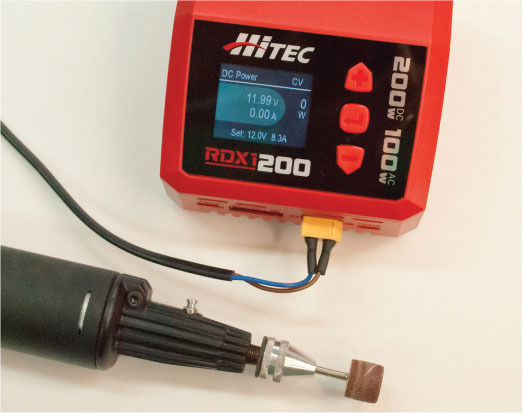➟ New Products That Are Worth a Closer Look
As seen in the September 2024 issue of Model Aviation.
TERRY DUNN shared his review of the Hitec RCD RDX1 200 charger. The following is what he had to say:
At first glance, the Hitec RDX1 200 appears to be a compact, single-port charger. While this device is indeed a capable charger, it also has a few unique features that make it a versatile electronic multi-tool for hobbyists.
The RDX1 200 can run on AC or DC power. Hitec provides cords for both types of inputs. When using AC input, this bantam charger has a maximum output of 100 watts (volts × amps). For example, you can charge a four-cell LiPo battery at up to 5.9 amps (16.8 volts × 5.9 amps = 99 watts). With DC input, the RDX1 200 can charge at up to 200 watts. An internal fan helps keep things running cool.
The Hitec RDX1 200 is a compact AC/DC charger that is capable of charging at up to 200 watts. It also performs other useful functions.
This little, red charger can handle four types of lithium batteries with up to six cells in series: LiPo, LiHV, LiFe, and Li-Ion. An XT-60-style battery connector is built into the front of the charger. Hitec offers adapters for those who use other types of power plugs. There is also a port for connecting balance plugs.
The RDX1 200 is capable of charging NiCd and NiMH batteries with up to 15 cells. Hitec offers an optional temperature sensor (part 44159) that is recommended when charging these types of cells. This charger can also be used to charge lead-acid batteries up to 12 cells (24 volts).
Many modelers are passionate about analyzing the performance of their battery packs. The RDX1 200 lets you scratch that itch. You can connect the charger to your computer via a USB-C port. Hitec’s Charge Manager software monitors and graphs numerous aspects of the charging process.
Another handy feature for data junkies is the Battery Meter function. It displays the internal resistance of each cell in a lithium battery pack and calculates the combined resistance. The Battery Meter also measures the voltage of each cell to the thousandth of a volt and calculates the difference in the highest and lowest cells.
I like to keep a voltage checker in my flight box to quickly verify the charge state of a battery at the field. The RDX1 200 performs this function as well. You simply plug the balance lead from a lithium battery into the balance port of the charger when there is no AC or DC input connected. The screen will display the voltages of the individual cells, in addition to the total pack voltage.
When using AC input power, the RDX1 200 can be used as a 100-watt DC power supply for external devices.
I think the most unique feature of the RDX1-200 is that it can be used as a power supply. When using AC input power, it can provide DC voltage for external devices ranging from 2 to 30 volts, with a maximum power of 100 watts. This can be very useful in your workshop or at the field if you want to run a DC soldering iron, rotary tool, or other gadget.
A quick-start guide is included in the box. The full manual can be downloaded from the Hitec website. I found the RDX1 200 menus to be intuitive and easy to navigate. The only discrepancy I found occurs when using the plus and minus buttons to make menu selections. Pressing the plus button moves your selection upward within the menu, but the values decrease as you move up. The opposite is true for the minus button. It is not a huge deal, but the logic seems backward.
Overall, I have found the Hitec RDX1 200 to be a highly versatile tool. The charger’s small footprint makes it convenient to use in my workshop. It is also small enough to easily fit in my transmitter case for charging (and other jobs) at the field.
SOURCES:












Comments
Add new comment